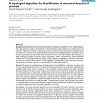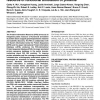59 search results - page 3 / 12 » EVEREST: automatic identification and classification of prot... |
BMCBI
2007
13 years 5 months ago
2007
Background: Identification of the structural domains of proteins is important for our understanding of the organizational principles and mechanisms of protein folding, and for ins...
BMCBI
2005
13 years 5 months ago
2005
Background: Protein domains have long been an ill-defined concept in biology. They are generally described as autonomous folding units with evolutionary and functional independenc...
BMCBI
2010
13 years 5 months ago
2010
Background: The classification of protein sequences using string algorithms provides valuable insights for protein function prediction. Several methods, based on a variety of diff...
NAR
2002
2002
The Protein Information Resource: an integrated public resource of functional annotation of proteins
13 years 4 months ago
The Protein Information Resource (PIR) serves as an integrated public resource of functional annotation of protein data to support genomic/proteomic research and scientific discov...
BMCBI
2008
13 years 5 months ago
2008
Background: Protein domains are the structural and functional units of proteins. The ability to parse proteins into different domains is important for effective classification, un...


